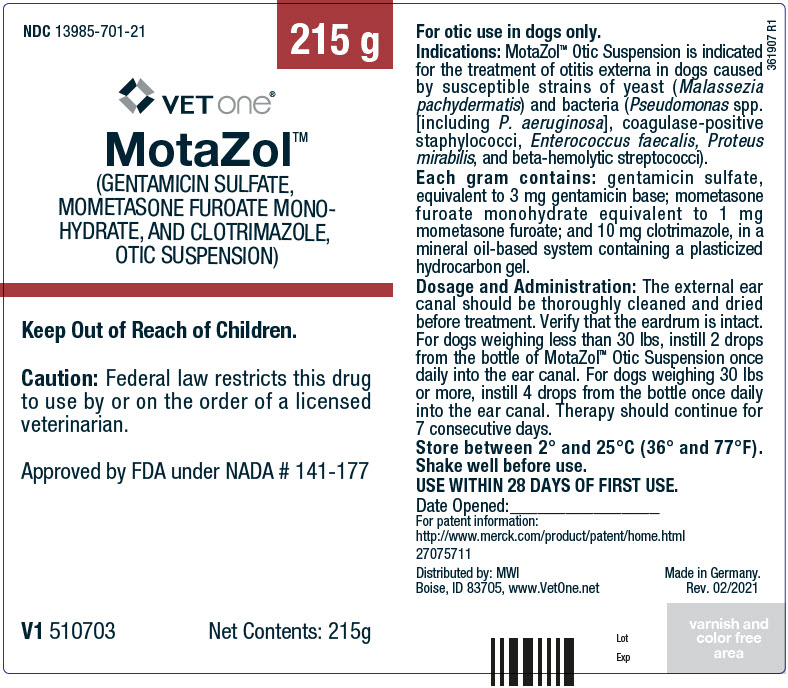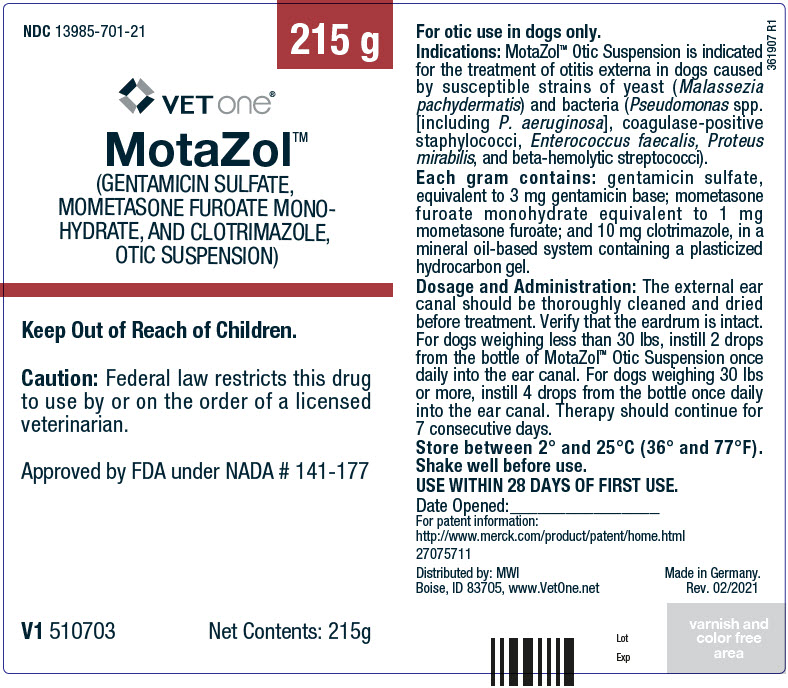Label: MOTAZOL- gentamicin sulfate, mometasone furoate monohydrate, and clotrimazole suspension
- NDC Code(s): 13985-701-07, 13985-701-15, 13985-701-21, 13985-701-30
- Packager: MWI
- Category: PRESCRIPTION ANIMAL DRUG LABEL
- DEA Schedule: None
- Marketing Status: New Animal Drug Application
Drug Label Information
Updated November 15, 2024
If you are a consumer or patient please visit this version.
- Download DRUG LABEL INFO: PDF XML
- Official Label (Printer Friendly)
- SPL UNCLASSIFIED SECTION
- SAFE HANDLING WARNING
- DESCRIPTION
-
PHARMACOLOGY
Gentamicin: Gentamicin sulfate is an aminoglycoside antibiotic active against a wide variety of gram-negative and gram-positive bacteria. In vitro tests have determined that gentamicin is bactericidal and acts by inhibiting normal protein synthesis in susceptible microorganisms. In clinical trials, gentamicin was shown to have a range of activity against the following organisms commonly isolated from infected canine ears: Pseudomonas spp. (including P. aeruginosa), coagulasepositive staphylococci, Enterococcus faecalis, Proteus mirabilis and beta-hemolytic streptococci.
Mometasone: Mometasone furoate monohydrate is a synthetic adrenocorticoid characterized by a novel (2) furoate 17-ester having chlorine at the 9 and 21 positions, which have shown to possess high topical potency.
Systemic absorption of mometasone furoate ointment was found to be minimal (2%) over 1 week when applied topically to dogs with intact skin. In a 6-month dermal toxicity study using 0.1% mometasone ointment on healthy intact skin in dogs, systemic effects typical of corticosteroid therapy were noted.
The extent of percutaneous absorption of topical corticosteroids is determined by many factors including the integrity of the epidermal barrier. Topical corticosteroids can be absorbed from normal, intact skin. Inflammation can increase percutaneous absorption. Once absorbed through the skin, topical corticosteroids are handled through pharmacokinetic pathways similar to systemically administered corticosteroids.
Clotrimazole: Clotrimazole is a broad-spectrum antifungal agent that is used for the treatment of dermal infections caused by various species of dermatophytes and yeast. The primary action of clotrimazole is against dividing and growing organisms.
In vitro, clotrimazole exhibits fungistatic and fungicidal activity against isolates of Trichophyton rubrum, Trichophyton mentagrophytes, Epidermophyton floccosum, Microsporum canis, Candida spp., and Malassezia pachydermatis. Resistance to clotrimazole is very rare among the fungi that cause superficial mycoses. In an induced otitis externa study using dogs infected with Malassezia pachydermatis, 1% clotrimazole in the vehicle formulation was effective both microbiologically and clinically in terms of reduction of exudate, odor, and swelling.
In studies of the mechanism of action, the minimum fungicidal concentration of clotrimazole caused leakage of intracellular phosphorus compounds into the ambient medium with concomitant breakdown of cellular nucleic acids and accelerated potassium efflux. These events began rapidly and extensively after addition of the drug. Clotrimazole is very poorly absorbed following dermal application.
Gentamicin-Mometasone-Clotrimazole: By virtue of its three active ingredients, MotaZol™ Otic Suspension has antibacterial, anti-inflammatory, and antifungal activity. In clinical field trials, MotaZol™ Otic Suspension was effective in the treatment of otitis externa associated with bacteria and Malassezia pachydermatis. MotaZol™ Otic Suspension reduced discomfort, redness, swelling, exudate, and odor.
INDICATIONS MotaZol™ Otic Suspension is indicated for the treatment of otitis externa in dogs caused by susceptible strains of yeast (Malassezia pachydermatis) and bacteria (Pseudomonas spp. [including P. aeruginosa], coagulasepositive staphylococci, Enterococcus faecalis, Proteus mirabilis, and beta-hemolytic streptococci).
CONTRAINDICATIONS If hypersensitivity to any of the components occurs, treatment should be discontinued and appropriate therapy instituted. Concomitant use of drugs known to induce ototoxicity should be avoided. Do not use in dogs with known perforation of eardrums.
WARNINGS The use of these components has been associated with deafness or partial hearing loss in a small number of sensitive dogs (eg, geriatric). The hearing deficit is usually temporary. If hearing or vestibular dysfunction is noted during the course of treatment, discontinue use of MotaZol™ Otic Suspension immediately and flush the ear canal thoroughly with a nonototoxic solution.
Corticosteroids administered to dogs, rabbits, and rodents during pregnancy have resulted in cleft palate in offspring. Other congenital anomalies including deformed forelegs, phocomelia, and anasarca have been reported in offspring of dogs that received corticosteroids during pregnancy.
Field and experimental data have demonstrated that corticosteroids administered orally or parenterally to animals may induce the first stage of parturition if used during the last trimester of pregnancy and may precipitate premature parturition followed by dystocia, fetal death, retained placenta, and metritis.
PRECAUTIONS Before instilling any medication into the ear, examine the external ear canal thoroughly to be certain the tympanic membrane is not ruptured in order to avoid the possibility of transmitting infection to the middle ear as well as damaging the cochlea or vestibular apparatus from prolonged contact.
Administration of recommended doses of MotaZol™ Otic Suspension beyond 7 days may result in delayed wound healing.
If overgrowth of nonsusceptible bacteria or fungi occurs, treatment should be discontinued and appropriate therapy instituted.
Avoid ingestion. Adverse systemic reactions have been observed following the oral ingestion of some topical corticosteroid preparations. Patients should be closely observed for the usual signs of adrenocorticoid overdosage which include sodium retention, potassium loss, fluid retention, weight gain, polydipsia, and/or polyuria. Prolonged use or overdosage may produce adverse immunosuppressive effects.
Use of corticosteroids, depending on dose, duration, and specific steroid, may result in endogenous steroid production inhibition following drug withdrawal. In patients presently receiving or recently withdrawn from corticosteroid treatments, therapy with a rapidly acting corticosteroid should be considered in especially stressful situations.
TOXICOLOGY Field and safety studies with MotaZol™ Otic Suspension have shown a wide safety margin at the recommended dose level in dogs (see PRECAUTIONS/ADVERSE REACTIONS).
Gentamicin: While aminoglycosides are absorbed poorly from skin, intoxication may occur when aminoglycosides are applied topically for prolonged periods of time to large wounds, burns, or any denuded skin, particularly if there is renal insufficiency. All aminoglycosides have the potential to produce reversible and irreversible vestibular, cochlear, and renal toxicity.
Mometasone: ALP (SAP) and ALT (SGPT) enzyme elevations, weight loss, anorexia, polydipsia, polyuria, neutrophilia, and lymphopenia have occurred following the use of parenteral, high-dose, and/or prolonged or systemic synthetic corticosteroids in dogs. Cushing's syndrome in dogs has been reported in association with prolonged or repeated steroid therapy.
Clotrimazole: The following have been reported occasionally in humans in connection with the use of clotrimazole: erythema, stinging, blistering, peeling, edema, pruritus, urticaria, and general irritation of the skin not present before therapy.
MotaZol™ Otic Suspension: In field studies following once-daily treatment with MotaZol™ Otic Suspension, ataxia, proprioceptive deficits, and increased water consumption were observed in less than 1% of 164 dogs. In a field study following twice-daily treatment with MotaZol™ Otic Suspension, inflammation of the pinna and diarrhea were observed in less than 1% of 141 dogs.
DOSAGE AND ADMINISTRATION
The external ear canal should be thoroughly cleaned and dried before treatment. Verify that the eardrum is intact. For dogs weighing less than 30 lbs, instill 4 drops from the 7.5 g, 15 g, and 30 g bottles (2 drops from the 215 g bottle) of MotaZol™ Otic Suspension once daily into the ear canal. For dogs weighing 30 lbs or more, instill 8 drops from the 7.5 g, 15 g, and 30 g bottles (4 drops from the 215 g bottle) once daily into the ear canal. Therapy should continue for 7 consecutive days.
-
PRINCIPAL DISPLAY PANEL - 215 g Bottle Label
NDC 13985-701-21
215 g
VET one®
MotaZol™
(GENTAMICIN SULFATE,
MOMETASONE FUROATE MONO-
HYDRATE, AND CLOTRIMAZOLE,
OTIC SUSPENSION)Keep Out of Reach of Children.
Caution: Federal law restricts this drug
to use by or on the order of a licensed
veterinarian.Approved by FDA under NADA # 141-177
V1 510703
Net Contents: 215g
-
INGREDIENTS AND APPEARANCE
MOTAZOL
gentamicin sulfate, mometasone furoate monohydrate, and clotrimazole suspensionProduct Information Product Type PRESCRIPTION ANIMAL DRUG Item Code (Source) NDC:13985-701 Route of Administration AURICULAR (OTIC) Active Ingredient/Active Moiety Ingredient Name Basis of Strength Strength GENTAMICIN SULFATE (UNII: 8X7386QRLV) (GENTAMICIN - UNII:T6Z9V48IKG) GENTAMICIN 3 mg in 1 g MOMETASONE FUROATE MONOHYDRATE (UNII: MTW0WEG809) (MOMETASONE - UNII:8HR4QJ6DW8) MOMETASONE FUROATE 1 mg in 1 g CLOTRIMAZOLE (UNII: G07GZ97H65) (CLOTRIMAZOLE - UNII:G07GZ97H65) CLOTRIMAZOLE 10 mg in 1 g Packaging # Item Code Package Description Marketing Start Date Marketing End Date 1 NDC:13985-701-07 1 in 1 CARTON 1 7.5 g in 1 BOTTLE, DISPENSING 2 NDC:13985-701-15 1 in 1 CARTON 2 15 g in 1 BOTTLE, DISPENSING 3 NDC:13985-701-30 1 in 1 CARTON 3 30 g in 1 BOTTLE, DISPENSING 4 NDC:13985-701-21 1 in 1 CARTON 4 215 g in 1 BOTTLE, PLASTIC Marketing Information Marketing Category Application Number or Monograph Citation Marketing Start Date Marketing End Date NADA NADA141177 03/15/2015 Labeler - MWI (019926120)

